Background
Non-native species (sometimes referred to as non-indigenous species) are animals and plants that have been moved to a location out-with their native range by human action, whether intentionally or not. Those that are not under control and have a significant adverse impact on native biodiversity, or socio or economic interests are referred to as invasive non-native species (INNS). These can alter local ecology by displacing or smothering native species, can disrupt some marine economic activities and have proven to be costly to manage.
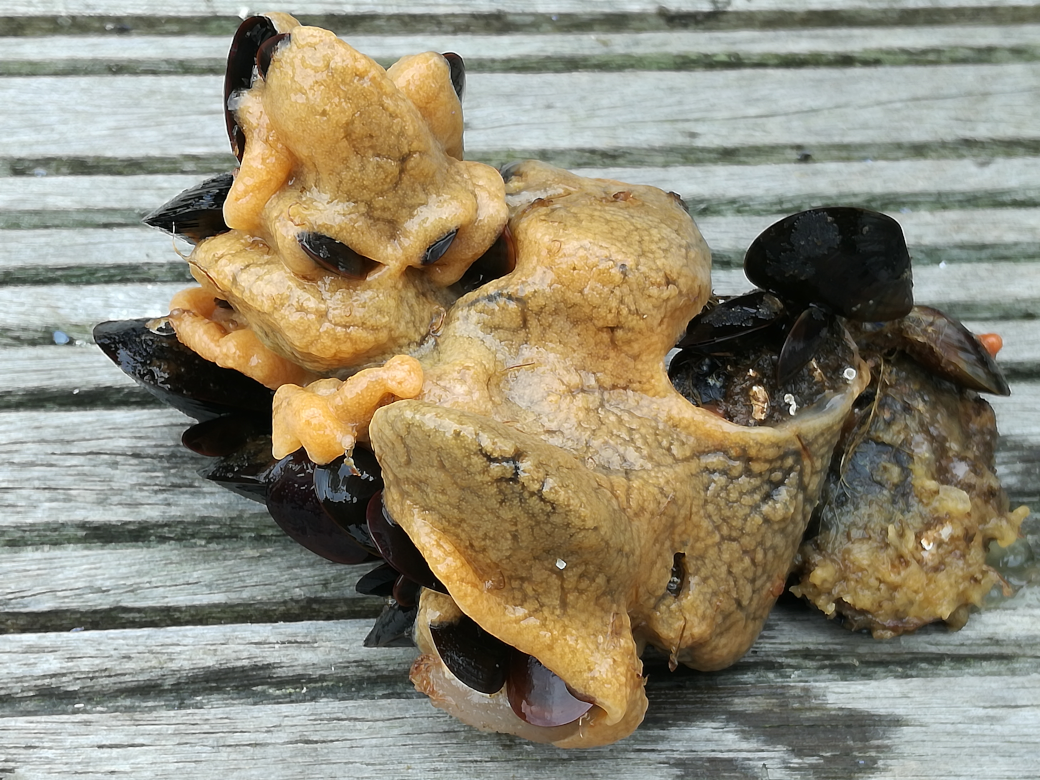
Figure 1: Carpet sea squirt, Didemnum vexillum growing on mussel shells © Sarah Brown.
In the UK known Non-Native Species (NNS) are categorised into high-, medium-, low- or unknown-impact species, based on likely impacts on biodiversity (Water Framework Directive (WFD) classification (UKTAG, 2015a).
The ‘high-impact NNS’ found within Scotland are: Common cord-grass (Townsend’s grass or rice grass, Spartina anglica); carpet sea squirt (colonial tunicate, Didemnum vexillum) (Figure 1) (see carpet sea squirt case study) and leathery sea squirt (Styela clava).
This assessment used the WFD water body classification method where the presence/absence of verified records of ‘high-impact’ species are recorded for each waterbody. The 2018 results were amalgamated to the scale of Scottish Marine Regions (SMR).
Each SMR was assigned a “red, blue, green” status as a gauge of the estimated pressure of NNS. SMRs that contain high-impact species were identified as ‘areas of high concern’ (red) and regions with moderate- or low-impact marine non-native species have been assessed as ‘areas of some concern’ (blue).
No comprehensive Scottish survey of NNS has been undertaken. All of the assessments so far are based on species reported through incidental finds, recorded during other monitoring programmes, or during local targeted surveillance following a report of non-native species.
Non-native species
In 2012, the Scottish Parliament approved the document ‘Non-native species: code of practice’. The code defines NNS as animals and plants that have been moved to a location out-with their native range by human action, whether intentionally or not. In other countries or contexts they may also be referred to as ‘alien’, ‘exotic’, or ‘non-indigenous’ species.
As well as posing a threat to biodiversity, invasive NNS (INNS) can disrupt a number of marine economic activities by fouling or smothering of shellfish and fish farms, marinas and mooring pontoons, or in extreme cases, fouling of waterway. It has proven to be costly to manage these impacts and to date, there has been no wholly successful eradication of a marine NNS (Sambrook et al., 2014).
The globally agreed response in the marine environment is to focus on preventing introduction and spread of NNS. This is reflected in various international conventions, agreements, EU directives and national strategies. Action has been progressed through
- global measures, such as the International Maritime Organisation’s International Convention for the Control and Management of Ships’ Ballast Water and Sediments (known as the ‘Ballast Water Management Convention’) (IMO, 2019) has set the standards of ‘no living biota’ to be discharged from water or ballast sediments to prevent spread of NNS between countries;
- GB Invasive Non-Native Species Strategy
- national measures such the UK Pathways Project (NNSS, 2019); and
- regional biosecurity plans to deal with specific outbreaks of an NNS.
Pathway management
Collectively the various strategies and action plans that currently exist look at activities that can spread NNS, known as pathways, and seek to manage them through a series of actions to improve ‘biosecurity’. Known marine pathways include ballast water transfer, aquaculture equipment and stock movements, vessel fouling and even deliberate (and illegal) release of some species. Actions to manage such pathways are identified by considering which points in an activity NNS may be transferred or released, and which mitigation (i.e. biosecurity) measure can be introduced to minimise the risk. In some cases legal powers can be used for action that can be taken to help manage pathways (Payne et al., 2014).
NNS impacts
NNS are identified as a pressure on biodiversity. Whilst there is evidence from around the world that invasive NNS can colonise, displace, smother, compete with and disrupt native species and habitats, there is scant understanding of their levels of establishment or impacts within UK waters.
Within the UK a list of NNS is regularly revised as knowledge of their impacts is developed. Only NNS that are assessed (GBNNSS, 2019) as having a ‘high-impact’ are considered a pressure on native marine biota and habitats. For the purposes of this Scottish Marine Assessment 2020 the ‘high impact’ species list for 2018 water body classification was used, as identified in the UKTAG Working Paper 7.6 (2015a).
High impact species
The high-impact marine species within Scotland are:
Common cord-grass, Townsend’s grass or rice grass (Spartina anglica).
Carpet sea squirt, colonial tunicate, (non-native Didemnum vexillum).
Leathery sea squirt (Styela clava).
Japanese kelp, Wakame (Undaria pinnatifida) (subject to final confirmation as high-impact species).
Common cord-grass, Townsend’s grass or rice grass (Spartina anglica)
This species is a terrestrial, coastal species, native to eastern USA that has an impact on coastal habitats, such as saltmarsh. However, it has down-stream impacts on intertidal mudflats and shallow subtidal habitats, and has recognisable impacts in seagrass beds (Davison & Hughes, 1998). Common cord-grass is an invasive pioneer species, a hybrid of introduced and native cord-grass species, which colonises the upper parts of mudflats. Its rapid growth consolidates sediment, raises mudflats and reduces sediment availability elsewhere. Studies in England have shown that this species has been linked to the reduction of the success of seagrass species and caused a reduction in seagrass density in Lindisfarne, Northumberland. This was caused by common cord-grass encroachment and consequential changes in sediment dynamics (Davison et al., 1991).
Before the impacts of this species were understood it was deliberately planted in coastal areas to stabilise soft sediments during land reclamation (Hubbard & Stebbings, 1967). More recently, it has been subject of eradication exercises, with some success in the Cromarty Firth (SNH, 2011).
Carpet sea squirt; colonial tunicate; (non-native Didemnum vexillum)
This is a colonial sea squirt, from the North-West Pacific, and was first reported in Scotland in 2009 (Beveridge et al., 2011). The species was initially found in the Firth of Clyde and has now been found in Argyll. This highly invasive species can rapidly colonise artificial substrates and smother sessile habitat and is thought to be easily spread via a number of vectors, including larval release in temperate climates, and attachments of fragments to substrates and biota (Carman et al., 2014). Despite several attempts, there have been no recorded successful eradication attempts for this species in marine waters (Holt & Cordingley, 2011; Ordóñez, 2015).
Leathery sea squirt (Styela clava)
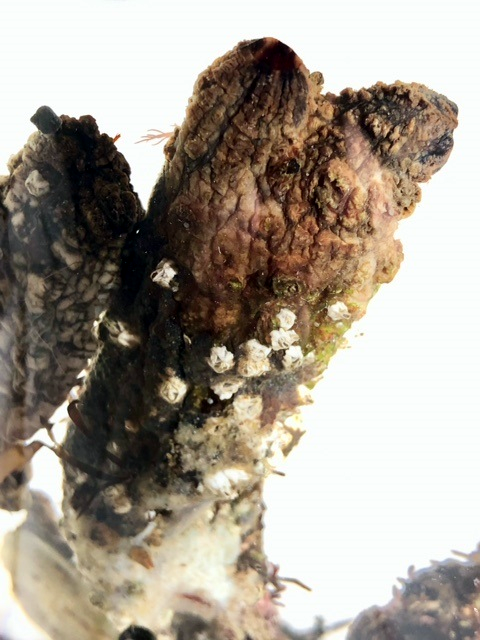
Figure a: Leathery sea squirt (Styela clava) © J. Khan
This sea squirt, from the North-West Pacific, was first found in Scotland in 1981 (Lutzen, 1999) and has spread up the west coast as far north as the Isle of Skye. Leathery sea squirt is capable of colonising a variety of intertidal and shallow subtidal habitats, taking advantage of gaps in substrata and artificial substrates where it displaces native sea squirts (Ciona intestinalis) (Lutzen, 1999). The species is established in a variety of natural habitats, including low or variable salinity habitats, and soft sediment habitats (subtidal muds and sands). It has also colonised hard substrates and can foul sedentary species, such as oyster, blue mussels and native sea squirts. It can be an aggressive invader and in Canada without any natural predators it has produced dense local populations that disrupt native biota (Clark & Therriault, 2007). There have been no successful eradication attempts of this species in the UK.
Other species
Japanese kelp (Undaria pinnatifida)
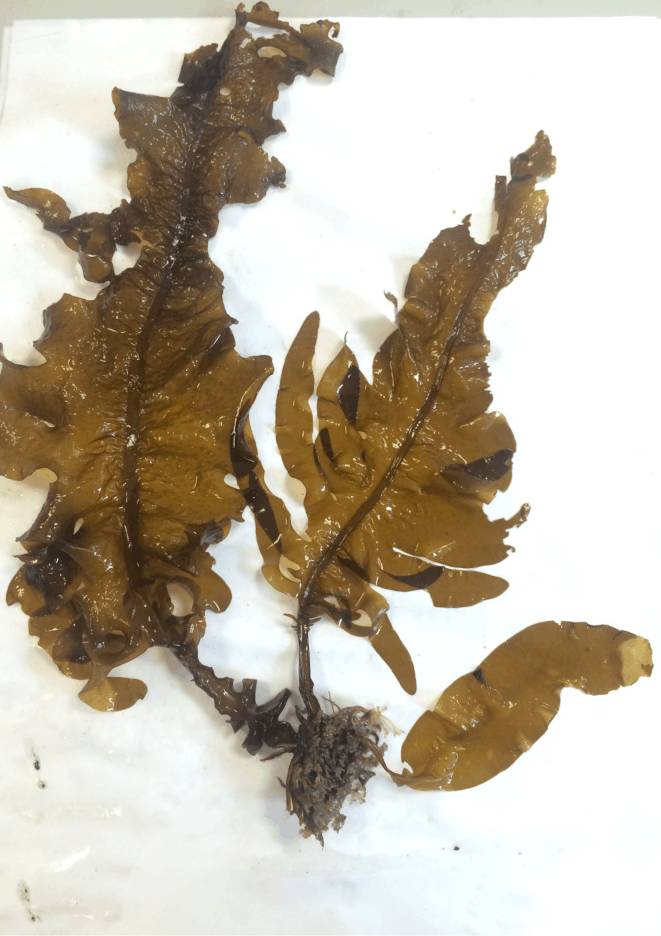
Figure b: Japanese kelp (Undaria pinnatifida) © J. Khan
Japanese kelp, from the North-West Pacific, was first recorded in Scotland in 2016, on an artificial substrate where it has colonised man-made structures. This species has not yet been classified as a high-impact species by the GB non-native species secretariat, and is currently recorded as being of unknown impact. However, due to its impacts in other countries, there has been sufficient concern that a risk assessment of the impacts is being undertaken. In other countries, it has colonised vulnerable habitats such as kelp habitats and subtidal seaweed habitats. Japanese kelp is currently unknown on any natural substrates in Scottish seas.
There have been no studies of impacts of established population of Japanese kelp in the UK. However in Argentina, where this species has been established for a number of years, they have seen a reduction of native species (Casas et al., 2004). In areas of New Zealand with similar climate and conditions to Scotland, studies show that rather than directly compete with native species, this species appears to rapidly colonise where native species have been damaged or not yet colonised (Scheil & Thompson, 2012). In Europe Japanese kelp has been observed to be a rapid coloniser of new habitats such as marina pontoons (Munchen & Nunn, 2014). There have been no recorded successful eradication attempt for this species.
Wireweed (Sargassum muticum)
Wireweed is from Japan and not classified as a high-impact species by the GB non-native species secretariat (UKTAG, 2015a), but it is included in this summary as it was the only species that was included in the 2011 Scottish assessment (Baxter et al., 2011). It is recognised as a significant threat to habitats where it can displace other alga and disrupt habitats. Wireweed is widespread and established in Scotland, and as far as it is known has not yet disrupted any habitats (Harries et al, 2007). Habitats at risk include subtidal and intertidal seaweed communities and kelp habitats. So far wireweed tends to occur in isolated clumps in the intertidal and has not yet been recorded as having displaced other species.
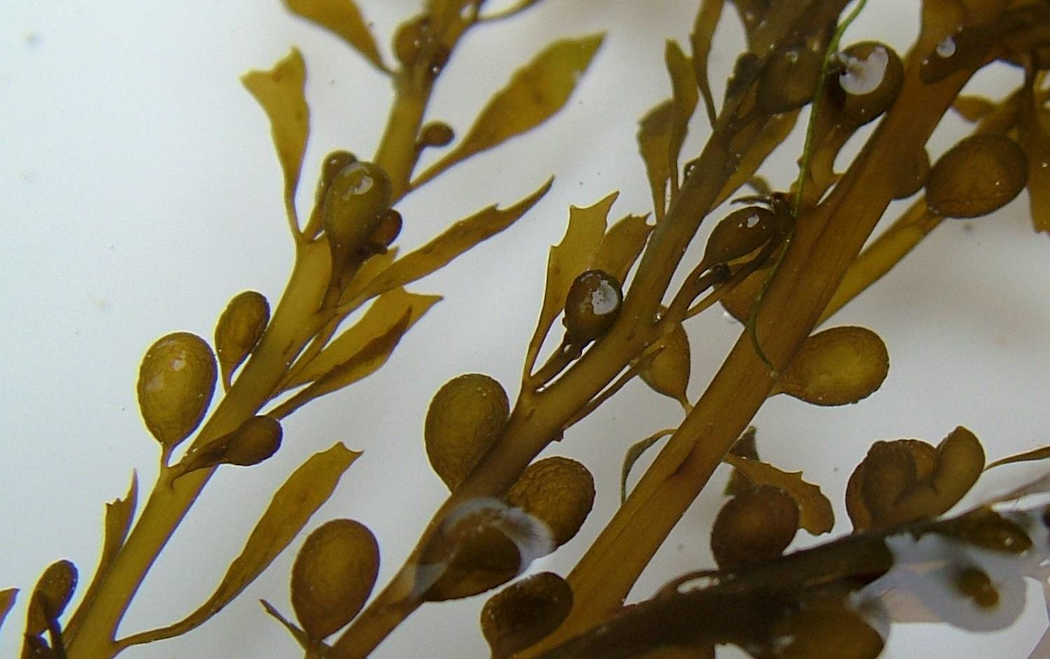
Figure c: Wireweed © NatureScot.
What is known about this species has been derived from studies in England; the brown seaweed (Halidrys siliquosa) has been reported to be displaced as the dominant species in rock pools by wireweed and, where wireweed was dominant in the subtidal, a decrease in other seaweed species have been noted (Eno et al., 1997). On the south coast of England, wireweed competes for space in the lower shore lagoons of the Solent (Strong et al., 2006) and there are records in England that wireweed has been found attached to shells and pebbles, and has successfully colonised areas of seagrass beds left open by disturbance (Davison & Hughes, 1998). However, as wireweed is not categorised as a high-impact species, and there is no evidence of this species causing ecological harm in Scottish waters, then this species has not been included in this assessment.
There are a number of high-impact species established in UK waters however, they have not yet been recorded, or verified in Scotland. These are:
Slipper limpet (Crepidula fornicata).
American oyster drill (Urosalpinx cinerea).
Marine tubeworm (Ficopomatus enigmaticus).
Chinese mitten crab (Eriocheir sinensis).
Slipper limpet (Crepidula fornicata)
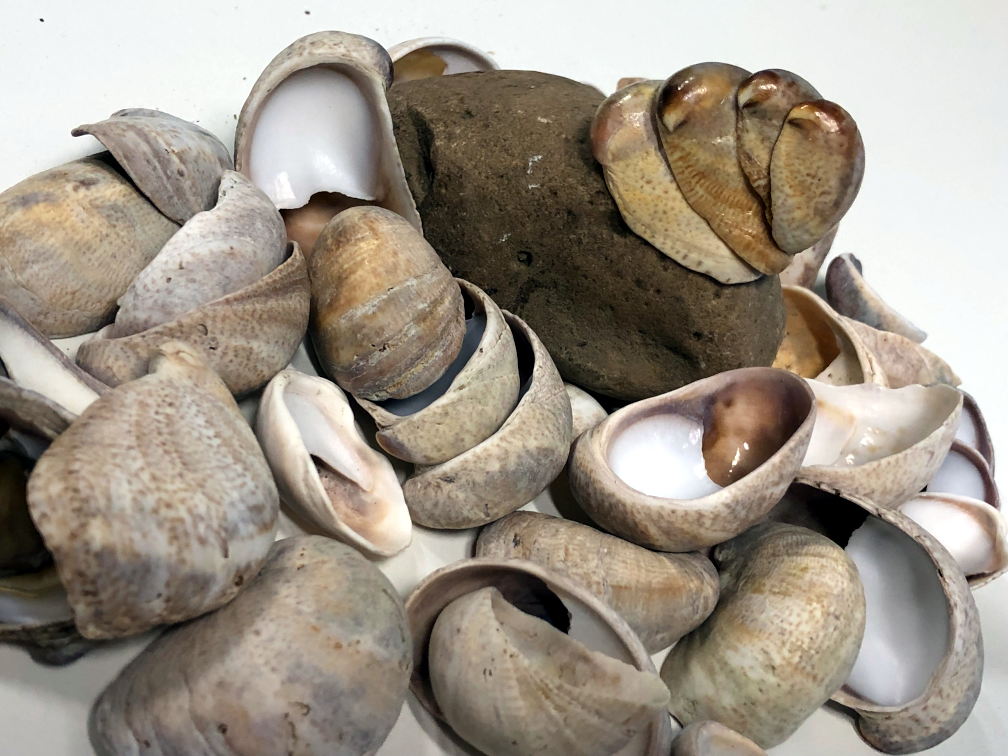
Figure d: Slipper limpet (Crepidula fornicata) © J. Khan
The slipper limpet, from the East coast of USA, has not yet been verified in Scotland, however is found in Strangford Lough, Northern Ireland. This species was accidentally introduced to the UK in the 1880s and has now been recorded as having a serious impact on natural habitats. The slipper limpet competes for space, while the build-up of its faeces, pseudo-faeces and siltation smothers native species and renders the substratum unsuitable for re-settlement by many native species. Where successful, this invasive species can change the entire biotope, to produce a slipper limpet dominated biotope. This can result in the loss of native populations of vulnerable species and habitats, such as blue mussels in Germany (Thielteges, 2005), native oyster beds in the South of England (Blanchard, 1997; Eno et al., 1997). In northern France, severe damage to maerl beds has been recorded where coralline algae and many of its associated species have been smothered (Grall & Hall-Spenser, 2003).
Within Scotland vulnerable habitats include oyster beds, mussel, maerl, kelp and seaweed communities. All are identified as being at risk should slipper limpets become established, changing the character of the substratum and thus preventing the recruitment of native species. There has only been one record of a partially-successful eradication attempt of this species in the UK (Bohn, 2014).
American Oyster drill (Urosalpinx cinerea)
The American oyster drill is not currently recorded in Scotland, but is established in south east and south west of the UK. Native oyster beds are a highly sensitive to impacts from this species as it is a major predator of oyster spat and is also considered to be a major pest on commercially cultured oyster beds (Korringa, 1952; Yonge, 1960). This species is thought to be a contributor to the more recent declines in native oyster populations and their associated living reefs and species in the south of the UK and France.
Australian tubeworm (Ficopomatus enigmaticus)
This species is confined to brackish waters and thrives in brackish lagoons and currently is only known within controlled, ‘warmed’ waters of ports and harbours in England and Wales. Its known northern limits within the UK are Cumbria on the west coast. It is thought that the water temperature has so-far limited its distribution to warmer southern sites in the UK (Zibrowius & Thorp, 1989). Where established in large populations, this filter-feeder competes with native filter-feeders and its pseudo-faeces can impact on water quality (Davies et al., 1989).
Chinese mitten crab (Eriocheir sinensis)
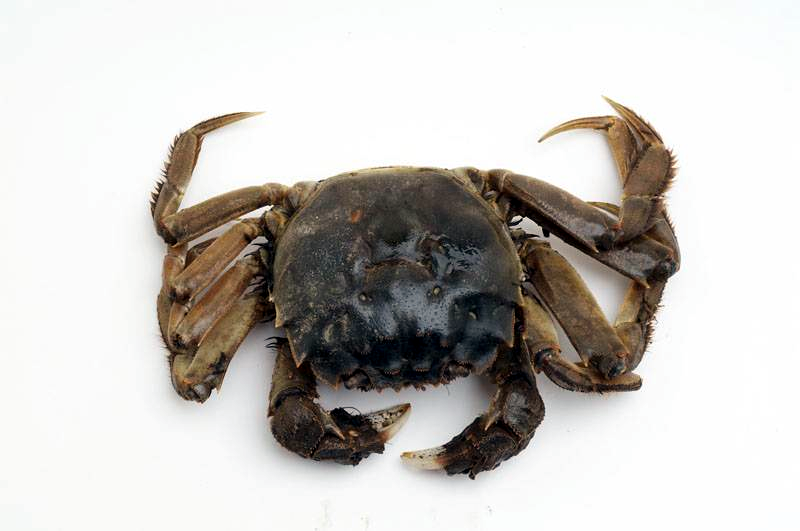
Figure e: Chinese mitten crab. © Crown 2009 The Food and Environment Research Agency.
There was a report of a Chinese mitten crab found in the River Clyde in 2016 (Yeomans & Clark, 2016). However, this was only the empty shell thought to have been discarded from a food retailer. Subsequent surveillance exercises have not recorded any live specimens, nor established populations of this species in the Clyde, nor in Scotland. The nearest verified population of Chinese mitten crab has been found in North Wales. This is a highly invasive species that can impact on freshwater, brackish and marine systems. It spends much of its life in brackish and freshwaters, but returns to the sea to breed (GSID, 2019). It is an opportunistic omnivore and predates on any sessile species including algae and invertebrates, but can have devastating effects on fish egg populations (Gollasch & Nehring, 2006). Its burrowing activities can undermine natural and artificial coastal and river embankments and has been recognised in California as a threat to infrastructure, such as flood protection (Rudnick et al., 2000).
General information about NNS can be found on the GB Non-native species secretariat web site.
Biosecurity at a regional level
Understanding activities within an SMR that can spread marine NNS (i.e. pathways), can help assess the likelihood of NNS being introduced or spread within that region. Knowledge of specific biosecurity measures recommended in an area, and whether they are being implemented can help assess whether the risk is adequately managed. Information on pathways can also direct surveillance for NNS in general or high-impact species for WFD classification Current understanding of activities and biosecurity measures that are in place are summarised in Table a:
|
Scottish Marine Region
|
Verified major activities that potentially spread marine non-native species
|
Known biosecurity measures within Scottish Marine Region
|
|
Forth and Tay
|
Energy production & associated infrastructure; Infrastructure: ports harbours and coastal development; Shipping; Tourism and Recreation
|
None
|
|
North East
|
Energy production & associated infrastructure ; Infrastructure; ports harbours and coastal development; Shipping; Tourism and Recreation
|
None
|
|
Moray Firth
|
Infrastructure: ports harbours and coastal development; Shipping; Tourism and Recreation
|
None, although some eradication attempts of Spartina recorded
|
|
Orkney Islands
|
Aquaculture; Shipping; Tourism and Recreation
|
Yes, Ballast Water Management Policy for Scapa Flow. NNS monitoring programme in place. Case study here
|
|
Shetland Isles
|
Aquaculture; Shipping; Tourism and Recreation
|
Yes, Shetland Biosecurity Plan
|
|
North Coast
|
Shipping; Tourism and Recreation
|
None
|
|
West Highlands
|
Aquaculture; Shipping; Tourism and Recreation
|
None
|
|
Outer Hebrides
|
Aquaculture; Shipping; Tourism and Recreation
|
None
|
|
Argyll
|
Aquaculture; Shipping; Tourism and Recreation
|
Yes, Loch Creran Community Biosecurity Action Plan and Loch Fyne Community Biosecurity Plan
|
|
Clyde
|
Infrastructure: ports harbours and coastal development; Shipping; Tourism and Recreation
|
Yes, Firth of Clyde Biosecurity Plan
|
|
Solway
|
Energy production & associated infrastructure; Shipping; Tourism and Recreation
|
Yes, Solway Firth Biosecurity Plan, plus Spartina eradication programme as well as Pacific oyster eradication attempts
|
The existing biosecurity plans for Scotland range from the simple “Check-Clean-Dry” advice to all water users (GBNNSS campaigns 2020 website), to bespoke community-led plans such as the Loch Creran Community Biosecurity Action Plan (Brown, et al., 2017). Biosecurity plans can be drawn up to reflect unique situations and activities following advice for marine biosecurity planning (Payne et al., 2014). This is a risk-assessment based planning that highlights vectors of spread and contamination that can be addressed by all water-users within the area of risk.
Non-native species assessment
At this time there is no comprehensive surveillance and monitoring programme for NNS in Scottish, or UK, waters. Present knowledge is based on verifying reports, academic work and specific local monitoring programmes, including those in known outbreak areas.
On a large-scale basis (North East Atlantic Ocean), there is an OSPAR assessment: ‘Human, Pressure, Trends in new records of non-indigenous species introduced by humans’. This gives an understanding on the level of introduction of ‘Non-Indigenous Species to all UK waters’ and includes all known species that are recorded within the UK. The OSPAR assessment is useful for predicting species arriving from European and non-European countries and can help inform an ‘Alarm List’ (UKTAG, 2015b) that highlights the species that may be introduced to Scotland in the next 5-10 years. Overall, the large geographic scale of the OSPAR assessment cannot be used to monitor introductions, or spread of species within Scotland, nor would it give any understanding of the impacts of these species on Scotland’s biodiversity.
Currently the classification of water bodies in relation to the Water Framework Directive (WFD) is the only Scottish assessment indicator that considers NNS and attempts to gauge their impact on marine biodiversity. The Scottish Environment Protection Agency (SEPA) undertakes this assessment. This SMA 2020 uses the method and criteria agreed for reporting on the WFD, where NNS are assessed as part of the Biological Quality Elements described by WFD Directive Article 5 and used in the classification process (WFD CIC, 2005).Within Scotland all open waters are split into management units called water bodies. These are classified using a system of five quality classes (High, Good, Moderate, Poor and Bad).
The assessment of NNS within an SMR follows the methods agreed at UK level by the WFD UK Technical Advice Group Alien - Species Group (UKTAG , 2013). The Great Britain Non-Native Species Secretariat (GBNNSS) have risk assessments for non-native species, that have been peer reviewed and published on the GBNNSS website (GBNNSS, 2019). Species rated as ‘high-impact’ are assumed to have a negative ecological impact; these are listed, and used to assess the ‘Biological Quality Element’ of waterbody classification (UKTAG, 2015a). The ‘high impact’ species list is regularly revised as the understanding of their impacts is developed. Although this is a basic procedure, it is a good proxy to assess ecological impacts of NNS on biodiversity.
For the 2018 assessment the marine species identified in the UKTAG Working Paper 7.6 (UKTAG, 2015a) are listed in Table b.
|
Common name
|
Species
|
Species risk assessment completed by GB non-native species secretariat
|
|
Common cord-grass, Townsend’s grass or rice grass
|
Spartina anglica
|
Pending
|
|
Chinese mitten crab
|
Eriocheir sinensis
|
Yes (GBNNSS (2016))
|
|
Slipper limpet
|
Crepidula fornicata
|
Yes
|
|
Leathery sea squirt
|
Styela clava
|
No
|
|
American oyster drill
|
Urosalpinx cinerea
|
Pending
|
|
Carpet sea squirt,
colonial tunicate
|
Non-native Didemnum vexillum
|
Yes (GBNNSS (2012))
|
|
Marine tubeworm
|
Ficopomatus enigmaticus
|
No
|
|
Japanese kelp
|
Undaria pinnatifida
|
Pending
|
High impact species and Scottish Marine Region NNS assessment
The ‘high-impact’ species status is based on experiences and understanding of these species from encounters in other parts of the UK or nearby countries. A number of the NNS have no risk assessment or an uncompleted one. In these cases, expert judgement is used in combination with the precautionary principle until there is evidence that this species is not a high-impact species in the UK. To date there are few studies that actually assess the impacts of these species on Scottish or UK marine biodiversity.
According to the classification method statement agreed at UK level (UKTAG, 2017), a verified record of an established high-impact species causes a downgrade in classification in that water body. The geographic area covered for the classification assessment is the whole of the coast of Scotland, out to 3 nautical miles and includes enclosing water bodies, such as firths and minches.
The water body classification for 2018 was used for the SMRs assessment. This assessment considers 11 inshore SMRs only; no assessment for the offshore regions have been made because the WFD assessment which provides the basic for the regional assessment only applies out to 3 nautical miles. To correct for the larger scale of SMRs, the 2018 WFD waterbody classification results were amalgamated to fit the inshore SMR scale using the one-out-all–out rule (where a single high-impact report in a waterbody is sufficient to downgrade the whole SMR). Additionally where the downgrade for an SMR was caused by a high-impact species that cannot be eradicated then this has been assessed as ‘many concerns’, using the assessment terminology. Where the downgrade is caused by the high-impact coastal species (common cord-grass) that can be eradicated, then the SMR assessment is recorded as ‘some concerns’.
Data collation
How best to use improve surveillance of marine NNS is currently being considered by Marine Scotland. Raising awareness of the species of concern and collation of verified data from reliable sources continues to be a priority. Under the Non-native species: code of practice Marine Scotland is identified as the lead agency for marine NNS. However, SNH, SEPA, Marine Scotland, as well as the Joint Nature Conservation Committee, undertake other monitoring and surveillance activities that lookout for these species, and share intelligence to inform on planning and contingency work.
Whilst there are no national surveys there is local surveillance. For example the annual surveillance for marine NNS in the Orkney Isles carried out by the Orkney Isles Marine Environmental Unit (Kakkonen et al., 2019): see case study. In addition, there have been a number of ad-hoc surveys in response to new records of NNS. These have mostly been undertaken to gain understanding of the local geographic spread of the species and an understanding of the level of establishment. Also there have been a number of informative research studies and surveys undertaken:
- Loch Creran (Didemnum vexillum) (MS/SNH/SAMS) (Brown et al., 2016)
- Firth of Forth Survey. May 2017, Undaria pinnatifida, (pers comm SNH/MS/SEPA)
- Clyde estuary (Didemnum vexillum) (Beveridge et al., 2011)
- Scottish Association of Marine Science Surveys (marinas, moorings and UK Buoy network) (2009 - ongoing) (Funded PhDs by NERC and MASTS, plus EU funding share from the UK Marine Pathways Project)
- West coast of Scotland Sargassum surveys (Davison et al., 2008; Trendall et al., 2010)
- North coast of Scotland, including Orkney (Nall, Guerin, & Cook, 2014).
For annual waterbody classification marine NNS data are collated from a variety of sources. These include other agency data records of incidents reported during routine monitoring and publicly sourced records, such as citizen science (UKTAG, 2017). All these sources of data come with varying degrees of confidence. Therefore, the accuracy of data is checked, species identification verified, and any observations on level of establishment or evidence of impacts on other biota are confirmed. The records are peer reviewed by SNH, MS and SEPA staff. Where difficult species are encountered, their identification is initially outsourced (Scottish Association for Marine Science, Centre for Ecology and Hydrology, and Plymouth Marine Laboratory). For particularly difficult species identification is undertaken using DNA analysis of suspect invasive samples (Cottier-Cook et al., 2019).
Results
Scotland’s Marine Atlas (Baxter et al., 2011) suggests that some marine NNS were established in Scottish seas. Since 2011 more records of a number on NNS have been found, and better verifiable records have been kept. As public knowledge has increased some easily recognised species are being reported, and systematically verified and recorded.
Data from 2018 (Table 1) show that three high-impact species are confirmed as being established within the 11 inshore SMRs:
- Common cord-grass, Townsend’s grass or rice grass;
- carpet sea squirt, colonial tunicate;
- leathery sea squirt.
Japanese kelp is verified as new to Scotland and is established in the Forth of Forth. It has not currently been confirmed as a high-impact species as a risk assessment has not been completed, and therefore it is not used for classification for this assessment. However, it has been noted and recorded as a species of concern that has colonised artificial substrate within the Firth of Forth (Forth and Tay SMR) and is the subject of measures to control and contain .
Three SMRs are considered as being areas having ‘many concerns’ and assigned a red status as they have been confirmed as having established populations of high-impact NNS. These are West Highland (with leathery sea squirt), Argyll (with leathery sea squirt) and Clyde (with leathery sea squirt and carpet sea squirt).
Six SMRs are assessed as having ‘some concerns’: amber status. Three of them contain the high-impact species common cord-grass, a species that is subject to an eradication programme: Forth and Tay, Moray Firth and Outer Hebrides. Three others contain a high number of other species that are not yet understood to have an impact in UK seas: Orkney Islands, Shetland Isles and Solway. These species may behave in an invasive way should environmental conditions change (e.g. climate change scenarios) and the presence of these non-native species indicate that there is a pathway for the more damaging species to arrive.
There was insufficient information to assess North East and North Coast. There are no SMRs that have been verified as NNS free. The confidence in this assessment is low as there are no Scotland-wide systematic surveys for marine NNS.
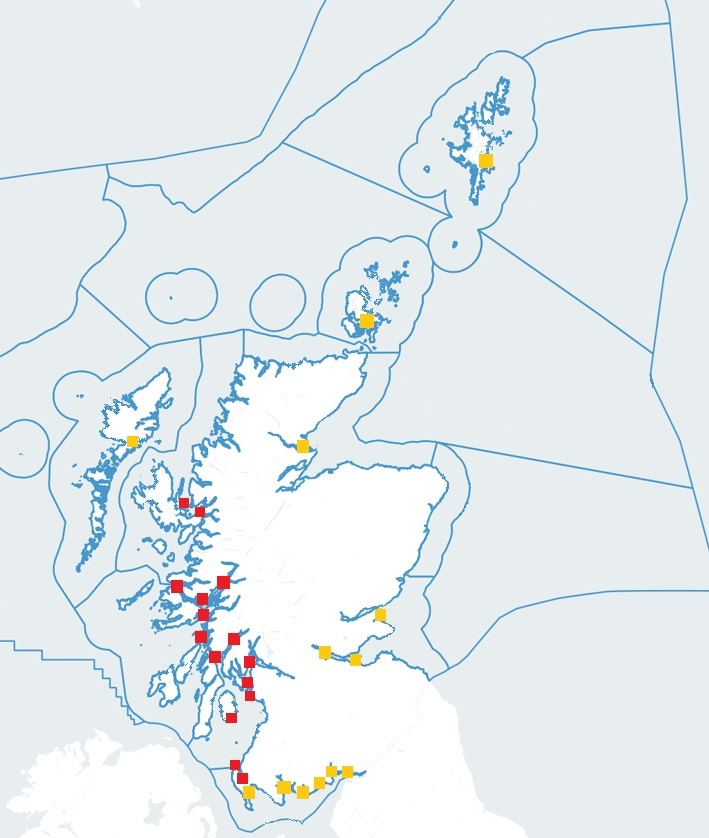
Figure 2: Map of verified records of high-impact non-native species within Scottish Marine Regions.
Key: Yellow dots indicate known records of the coastal species Spartina; Red dots indicate all marine high-impact species. Source: SEPA 2018 WFD classification database.
|
Scottish Marine Region
|
2018 assessment
|
Verified high-impact non-native species records
|
Verified records of medium, low and unknown impact non-native species (UK TAG, 2015)
|
|
Forth and Tay
|
Region of some concern
|
Common cord-grass (Spartina anglica)
|
Undaria pinnatifida
Magallana gigas (formally Crassostrea gigas)
Caprella mutica
|
|
North East
|
Not assessed due to lack of verified data
|
None recorded
|
Unverified reports of transient populations of red seaweed (possibly Bonnemaisonia hamifera) and Caprella mutica
|
|
Moray Firth
|
Region of some concern
|
Common cord-grass (Spartina anglica)
|
|
|
Orkney Islands
|
Region of some concern
|
None recorded
|
Asterocarpa humilis
Caprella mutica
Colpomenia peregrine
Corella eumyota
Red seaweeds (including Asparagopsis armata and Bonnemaisonia hamifera)
Tricellaria inopinata
Schizoporella japonica
|
|
Shetland Isles
|
Region of some concern
|
None recorded
|
Corella eumyota
Caprella mutica
Diadumene lineata
Fenestrulina delicia
Red seaweeds (including Bonnemaisonia hamifera and
Asparagopsis armata)
Schizoporella japonica
|
|
North Coast
|
Not assessed
|
Limited evidence
|
Caprella mutica
Schizoporella japonica
|
|
West Highlands
|
Region of many concerns
|
Leathery sea squirt (Styela clava)
Common cord-grass (Spartina anglica)
|
Magallana gigas
|
|
Outer Hebrides
|
Region of some concern
|
Common cord-grass (Spartina anglica)
|
Caprella mutica;
Sargassum muticum
|
|
Argyll
|
Region of many concerns
|
Leathery sea squirt (Styela clava)
Common cord-grass (Spartina anglica)
Carpet sea squirt (Didemnum vexillum)
|
Sargassum muticum
Magallana gigas
|
|
Clyde
|
Region of many concerns
|
Carpet sea squirt (Didemnum vexillum)
Leathery sea squirt (Styela clava)
Common cord-grass (Spartina anglica)
|
Sargassum muticum Magallana gigas
|
|
Solway
|
Region of some concern
|
Common cord-grass (Spartina anglica)
|
Sargassum muticum
Magallana gigas
|
As there have been no national surveys for NNS a baseline for species presence/absence does not exist, so there is no understanding of the time or the location of the first introductions. Since 2011 the Invasive Non-Native Species Framework Strategy for GB (GBNNSS, 2008) has identified priorities for management of NNS in the UK and in Scotland taking a more strategic approach to marine NNS will direct and encompass monitoring and surveillance aspects (pers comm Begg 2019).
A slightly improved understanding of marine NNS established in Scotland is now available. Verified records of the different types of species are available and it is known that they are more widespread than thought in 2011. It is assumed that the areas recorded as having NNS were hot-spots in 2011 and have spread from these areas since, but there is no evidence to support these assumptions, nor to prove that there are continuing new introductions due to any lack of biosecurity.
In 2011, only detailed distribution information for one species (wireweed was known, although the presence of other species (carpet sea squirt and common cord-grass) was noted. Since 2011, the Wildlife and Natural Environment (Scotland) Act (WANE) has set out provision for drawing up a code of practice for managing non-native species. The response in the marine environment is to focus on preventing the spread of NNS. This has been progressed through local and regional biosecurity plans to deal with specific outbreaks or to prevent the introduction of NNS during events and activities.
Since the 2011 Marine Atlas (Baxter et al., 2011) understanding of some of the species has changed and, where information is available, risk assessments have been undertaken on species that are present in the UK (GBNNSS, 2011). The risk assessments attempt to estimate the impacts caused by these species within the UK. Much of the evidence available for the assessments is derived from overseas observations and case studies in countries with similar climates to the UK (Ojaveer et al., 2015). If any substantive new scientific evidence becomes available on these species, then this can prompt a re-evaluation of the risks for the species in question and a change of its impact status. What has not fully changed since 2011 is the understanding of actual impacts on UK biodiversity, as this has not been investigated, even where species are recorded as being established, or reported as forming monocultures.
The WFD assessment has a slightly different approach in that it looked at smaller areas (coastal and estuarine water bodies) and attempted an ecological biological assessment of impact of these species. The water body level/scale of assessment for classification of water bodies is also carried out at a smaller scale so potentially could allow for better understanding of spread within the UK and Scotland, if the data were available, and help determine the success, or otherwise, of biosecurity plans.
Since 2011, UK bodies have determined a list of high-impact species to use for the classification assessment, and since 2011 the number of waterbodies with these species present has increased. However, as there is no systematic monitoring programme, it is difficult to understand whether this is a genuine spread of species, or whether awareness-raising has led to their occurrence to be noted and recorded by marine practitioners and the public.
Data confidence
As all the national records are derived from ad-hoc reporting, the absence record of a species from regions has low confidence. Where non-native species are reported there is medium confidence in the report if the record has been verified by experts. The process for assessing impacts on biodiversity has been agreed at UK level by the UK Technical Advice Group (UK TAG) using the best available information from the GB non-native species secretariat (GBNNSS). The overall assessment in data confidence is low.
Conclusion
In this assessment more records of NNS were recorded as established, as defined by WFD, at a wider range of locations in Scottish inshore waters than were recorded in 2011. However, due to the lack of systematic monitoring it is difficult to understand whether the increase of records are an indication that more species have arrived and spread since 2011, or whether species were present, but overlooked, prior to 2011 and only recently recognised and recorded. It is possible that awareness-raising and implementation of biosecurity measures have led to NNS being noticed and reported by marine practitioners, in particular, species of concern for industries that are impacted by them.
Although there is little evidence of how marine NNS affect Scottish biodiversity, this assessment assumes that, the presence of a high-impact species in a system has a detrimental effect on native biodiversity. The lack of specific, Scotland-relevant, evidence means that this assessment has a low confidence. Likewise, the lack of a Scotland-wide surveillance programme makes it difficult to assign a trend for the spread, and impacts of NNS.
Given the lack of evidence of impacts within Scotland, this assessment is very much reliant on expert judgement. Much of the expertise lies within academic and government institutions, or industries directly impacted by the effects of marine NNS. Information and knowledge is shared within these communities, as well as published websites such as the GB Non-native Species Secretariat website. When a high-impact species is found in a new location an alert is issued and appropriate actions are agreed.
The impacts of all the NNS found in Scotland are not understood and initially impact status is assigned based on judgement. Once evidence emerges of any species impacts then the status of that species is revised and where necessary, this is reflected in the annual waterbody assessment. One example of this is wireweed. This species was reviewed as it was originally considered as a high-impact species. Controversially, it was re-assessed as a low-impact species as it was considered to perform the same ecosystem function as the species that it replaced in the intertidal and near subtidal areas. This review very much depended on observations of this species on the south coast of the UK.
The 2011 Marine Atlas assessment showed the known spread of wireweed on the west coast of Scotland, but the actual impacts on vulnerable Scottish biodiversity are still not understood. This species is recorded as being established and, in some places in the UK, has been observed as forming monocultures. It is recognised as a significant threat to habitats where it can displace other alga and disrupt species assemblages. As far as it is known it has not yet disrupted any habitats. However, habitats at risk include subtidal and intertidal seaweed communities and kelp habitats. So far, in Scotland, wireweed tends to occur in isolated clumps in the intertidal and has not yet been recorded as having displaced other species. In Scotland the impacts noted in England have not been seen, where the brown seaweed (Halidrys siliquosa), and other seaweed species have been displaced by wireweed (Eno et al., 1997) nor has there been disruption of seagrass habitats as has been recorded in English south coast lagoons (Strong et al., 2006).
Between 2011 and this assessment there are verified records of high-impact NNS that were not found before 2011, despite there being local NNS surveys within SMRs. However, it is still difficult to assign a trend for Scotland with any confidence. This is because many of the records are from incidental reporting, rather from targeted surveillance and monitoring. There have been repeated small-scale local surveys and these have been used to assign trends in West Highland, Argyll, Clyde and Orkney SMRs. Prior to 2011, where there were surveys undertaken for targeted a species (Sargassum in the intertidal and shallow sub-tidal) but, the design of these surveys mean that high-impact species (carpet sea squirt and leathery sea squirt) could have been overlooked, as these species occur in deeper waters than the deployed surveys. However, from this assessment an overall trend for Scottish waters has been assigned as “declining” because of the now know presence of high-impact species.
In summary, there is only a partial understanding of the locations of NNS. There is some evidence collated of species distributions. Changes since 2011 may be due to an increased rate of reporting, rather than an increase of introductions or spread of species. There is as yet no understanding of the impacts of these species and developing biosecurity strategies and pathway management activity are at early stages.
Knowledge gaps
Key knowledge gaps are: presence and locations of NNS and how quickly they may be spreading; evidence based understanding of impacts on biodiversity in Scotland (or the UK) as most information comes from other countries; known mechanisms of establishment and whether native species disrupted by other stressors, or simply out-competed by NNS; and environmental triggers for the invasive behaviours.
Whilst records of marine NNS have increased since the atlas assessment in 2011, most knowledge has been derived from incidental records and targeted, as opposed to national, survey. In addition little is known about impacts in Scottish waters. The main knowledge gaps are:
- Baseline information; population estimates/establishment data: records tend to be ‘presence/absence’ data picked up in other monitoring and surveillance programmes, therefore population estimate is a minimum estimate (except when there have been targeted surveys to address outbreaks). Currently there are no criteria for determining when a species is ‘established’ and instead expert judgement on the number of NNS at a site, or whether it is reproducing is relied upon.
- Lack of information about pelagic NNS in Scottish seas: there are infrequent records of plankton NNS in pelagic waters but on the whole there is no consistent information and impacts are poorly understood. For example, an American copepod, a zooplankton (Eurytemora herdmani) was found in the Firth of Forth during three consecutive years sampling (Baptie et al., 2016), but there is no understanding of its impacts on endemic plankton species. In 2015 CEFAS surveyed the North Sea for American comb jelly (Mnemopsis leidyi) but did not include Scottish seas, so there are no data for Scottish waters for this recognised invasive species.
- Lack of knowledge on the ecological or economic impacts in Scottish waters: whilst there is evidence from around the world that species in waters with similar environmental parameters can be invasive and colonise, displace, smother, compete with and disrupt native species and habitats, little evidence has been collected their level of establishment and impacts in Scotland or the UK. Similarly there is little understanding about the behaviour of the NNS, especially of what triggers them to become invasive.
- Mechanism of establishment of NNS: there is some evidence to suggest that marine NNS are more likely to be established in areas where the environment is impacted by other pressures. However, it is difficult to know whether this is a reflection of the types of activities that introduce NNS or, whether the NNS have taken a competitive advantage over the native biota in a damaged system.
Status and trend assessment
|
Region assessed |
Status with confidence |
Trend with confidence |
| All Scotland |
|
|
|
Solway |
 |
NT |
|
Clyde |
|
|
|
Argyll |
|
|
|
Outer Hebrides |
 |
NT |
|
West Highlands |
|
|
|
North Coast |
 |
NT |
|
Shetland Isles |
 |
NT |
|
Orkney Islands |
 |
|
|
Moray Firth |
 |
NT |
|
North East |
 |
NT |
|
Forth and Tay |
 |
NT |
This Legend block contains the key for the status and trend assessment, the confidence assessment and the assessment regions (SMRs and OMRs or other regions used). More information on the various regions used in SMA2020 is available on the Assessment processes and methods page.
Status and trend assessment
|
Status assessment
(for Clean and safe, Healthy and biologically diverse assessments)
|
Trend assessment
(for Clean and safe, Healthy and biologically diverse and Productive assessments)
|
||
|---|---|---|---|
 |
Many concerns |
No / little change |
|
 |
Some concerns |
Increasing |
|
 |
Few or no concerns |
Decreasing |
|
 |
Few or no concerns, but some local concerns |
No trend discernible |
|
 |
Few or no concerns, but many local concerns |
All trends | |
 |
Some concerns, but many local concerns |
||
 |
Lack of evidence / robust assessment criteria |
||
| Lack of regional evidence / robust assessment criteria, but no or few concerns for some local areas | |||
 |
Lack of regional evidence / robust assessment criteria, but some concerns for some local areas | ||
| Lack of regional evidence / robust assessment criteria, but many concerns for some local areas | |||
Confidence assessment
|
Symbol |
Confidence rating |
|---|---|
|
Low |
|
|
Medium |
|
|
High |

Assessment regions

Key: S1, Forth and Tay; S2, North East; S3, Moray Firth; S4 Orkney Islands, S5, Shetland Isles; S6, North Coast; S7, West Highlands; S8, Outer Hebrides; S9, Argyll; S10, Clyde; S11, Solway; O1, Long Forties, O2, Fladen and Moray Firth Offshore; O3, East Shetland Shelf; O4, North and West Shetland Shelf; O5, Faroe-Shetland Channel; O6, North Scotland Shelf; O7, Hebrides Shelf; O8, Bailey; O9, Rockall; O10, Hatton.




